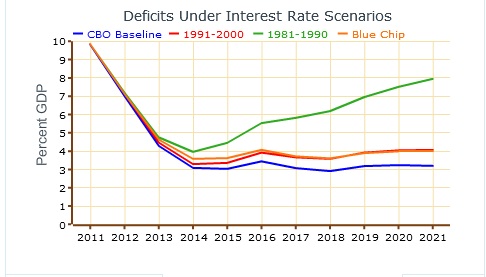The debt ceiling debate has dragged on creating frustration and some anxiety about the economic consequences of default. President Obama has even threatened to withhold Social Security checks, claiming there would be no money for payment. Through most of this he has seemed to me to be unserious about the matter and using it chiefly to try to improve his chances for re-election. Fred Barnes has now come up with what I consider a good explanation for his behavior, including the last moment maneuvers yesterday.
First, the trade treaties:
The path to ratification by Congress was greased after President Obama renegotiated trade treaties with South Korea, Colombia, and Panama. Obama would supply Democratic votes. Republicans were already on board, President Bush having put together the treaties in the first place. It had the look of a done deal.
It wasn’t. In May, the White House suddenly insisted the treaties be accompanied by roughly $1 billion in Trade Adjustment Assistance, or TAA as it’s known in Washington. Organized labor was demanding TAA funds be set aside for workers whose jobs might be lost as a result of the treaties. Obama took up the cause.
Then there was the oil pipeline from Canada:
The Keystone XL pipeline from the oil sands in Canada to refineries on the Gulf Coast is another win-win issue for Obama, if only he’d embrace it. Canada is America’s leading foreign supplier of oil. The more Canada exports to the United States, the less we’re forced to rely on unfriendly folks in the Middle East and on Latin American countries (Mexico, Venezuela) whose oil production is declining. With the new pipeline, Canada would increase its exports by as much as 700,000 barrels a day. (The United States consumes 10-11 million barrels daily.)
A permit to build the pipeline was requested nearly three years ago by TransCanada. Because it would cross an international border, approval must be granted by the State Department. This was expected to be a snap, particularly after gasoline prices reached $4 a gallon. White House aides thought so, and Secretary of State Hillary Clinton indicated she was ready to approve it.
Then the environmental lobby, led by the Natural Resources Defense Council, began a campaign against approval, and the Environmental Protection Agency joined in. It criticized the State Department’s first environmental impact statement, which found the pipeline would have little effect on the environment. Clinton buckled, and a second impact statement was ordered. Last month, EPA said the new study was “inadequate.”
Both of these initiatives promised thousands of new jobs and would seem to be helpful to Obama in his quest for a second term. In both cases, a left wing member of his base intervened and his support collapsed.
Now, the debt ceiling:
The Speaker and the President had nearly agreed on a plan that included $800 billion in “revenue enhancements” but did not raise rates. What happened ?
House Speaker John Boehner’s (R., Ohio) office is pushing back against White House claims that the new revenue in the “framework” being discussed in the now defunct negotiations would have been generated by letting current tax rates expire. “That is simply false,” writes Boehner spokesman Michael Steel.
In reality, Steel writes, the White House offered a “ceiling” of $800 billion in new revenue over 10 years that would be achieved through comprehensive tax reform (e.g., eliminating loopholes, credits and deductions) in a way that would stimulate economic growth. This would not constitute a tax increase.
Following the release of the Gang of Six proposal, however, the White House then insisted on an additional $400 billion in actual tax increases, for a total of $1.2 trillion in revenue that would become the new “floor” for revenues. Additionally, the administration backed away from several aspects of the tax reform package they had already agreed to, including a protection against tax hikes on small businesses and a guarantee that they would only be three tiers of tax rates, the highest of which would be below 35 percent.
In regard to Social Security, the two sides had agreed on a change in the way the government calculates inflation (the so-called “chain CPI”) that would extend the program’s solvency. However, the White House reneged on a previously agreed-upon solvency target and offered a weaker target that would yield 25 percent less in savings.
If true, clearly the two teams were playing in two separate stadiums.
What had happened was that the “Gang of Six” report was released and the revenue increases looked better to Obama so he reneged. There was also considerable discussion that Democrats were furious with him because he had not insisted on tax increases.
No. I think what happened is Congressional Democrats got a whiff of a possible deal where you get entitlement cuts and tax reform, say, next year — which might increase revenue or might not — and they panicked because a) they have a religious belief in raising the taxes. If you don’t have that, you can’t have a deal, so it created a kind of a theological panic.
Obama, it seems, cannot stand up to the rest of his party. He will negotiate but once some interest group objects, he is gone. No deal.
It’s a good thing the Soviet Union is gone.
UPDATE: More on the Democrats’ insistence that any deal has to raise taxes. This is probably tactical as they hope this will alienate the tea party.





